QIRX SDR
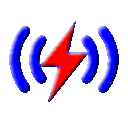
Digital Audio Broadcast : TII Collisions
Part I: What are TII Collisions?
A Tutorial by Clem, DF9GI
Digital Audio Broadcast (DAB) stations very often operate in a so-called "Single Frequency Network (SFN)".
In a SFN, they all transmit on the exactly same frequency, timely synchronized, disseminating the same content.
Very often not only one, but more transmitters contribute to the decoded audio of the receiver.
At the receiver side,
the only means to distinguish different transmitters in a SFN is their TII-Code (TII means Transmitter Identification Information),
extracted from the Null Symbol. Unfortunately, this TII Code is not guaranteed to be unique
like e.g. the ensemble id, but in certain circumstances it will become impossible
to extract the TII Code of a transmitter unambiguously.
Such a situation is what I call "TII Collision".
For an understanding what "TII Collisions" mean, we first need to understand how the TII Codes are extracted from the Null Symbol.
The Null Symbol
The "Null Symbol" is nothing more than controlled silence of 1.3ms. Every 96 milliseconds, a DAB station transmits - nothing -, making
a pause to give a receiver a chance to recognize the next starting instance of a so-called "frame". However that pause is not completely silent,
because just in there some carriers are activated which form the "TII Code".
But before we go into the details of how the TII Codes are constructed, let us first have a look at the Null Symbol.
The Null Symbol in the Time Domain
QIRX can show you the signal amplitude received over some time. The next picture is a QIRX screenshot of the I/Q Data, like
from an oscilloscope. The trigger point is the start of the new frame on the right hand side of the picture, adjusted by some delay to get the full
Null Symbol into display. "Time Domain" means that the horizontal scale is divided into units of time, however here not in seconds, but
in units of sample time. Each sample corresponds to a time of 1/2048000 seconds. Pretty fast, isn't it?
The picture shows the following:
-
On the left hand side the end of a frame is shown. You might well recognize the step, showing the end of not only one single
signal, but, at a reduced amplitude, also the end of a frame of a second transmitter, with some delay of about 150 samples.
For the overly curious, that very delay must show up also in the CIR spectrum. Check it out!
Therefore we conclude that we receive here our DAB signal from at least two transmitters simultaneously. We keep this result in
mind for later, when we come to the "Frequency Domain" in a second.
The middle part shows you the "controlled silence" in the form of zero amplitude. For completeness of the picture, on the right hand side
the "Phase Reference Symbol" of the newly started frame can be seen, which will be not of interest here.
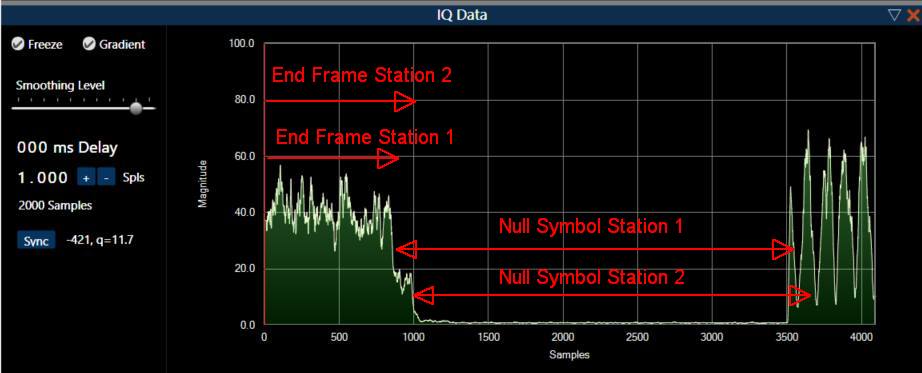
-
But where is the TII Code?
Shouldn't it be somewhere in the Null Symbol?
Ok, admitted, I didn't tell you the whole truth. The TII Code does NOT show up in every Null Symbol, but only in every second one.
This has technical reasons not of interest to us here.
To see it in QIRX, you only must add a delay of 96ms (i.e. delay by a whole frame time), and voilá, there it is,
contained in the strangley formed central part of the Null Symbol.
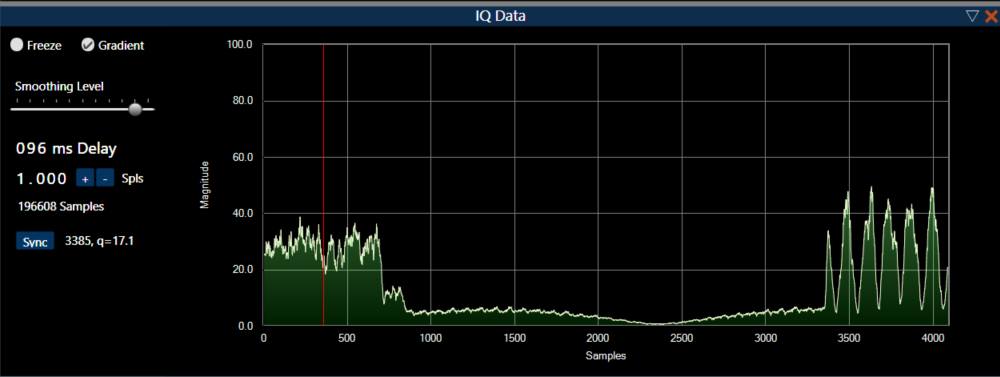
The different frequencies of the Null Symbol carriers superimpose each other, and form the active part of the Null Symbol.
Again, just for the curious, there are two ways to superimpose, one is correct, and one is wrong. Here you see the correct one,
with that notch in the middle.
Some transmitter manufacturers didn't read the ETSI spec well enough, and did it wrong. The drawback of that sometimes wrong solution
is another story, not of interest here.
The important question of interest is: "How can we extract the TII Codes from the Null Symbol".
Although I don't know for sure whether this is possible from the time domain signal, I assume nobody tried it, simply because it would
not make much sense.
What makes a lot of sense is to leave the time domain and look at the Null Symbol in the "Frequency Domain", meaning that we
investigate the different frequencies forming the TII Codes within the Null Symbol. A
"Fast Fourier Transform" will get us there within some microseconds (on our current superfast machines).
Ok, here we go.
The Null Symbol in the Frequency Domain
The next picture shows us the same Null Symbol as above in another representation, the Frequency Domain. Each of the colored lines represent
a single frequency in a spectrum of 2,048 different ones being active at the time when the Null Symbol is sent, i.e. every 2*96ms.

For an explanation how to extract the TII Code consisting of "Main Id" and "Sub Id" we will - in a first step - try to compare the explanation
given in the
ETSI DAB Standard
step-by-step with the spectrum shown above. In a second step it will become clear what it means when we say that "TII Collisions" might be present. Let us collect some properties
which might be extracted from the above spectrum, together with some additional information about the organisation of the TII spectrum.
-
16 strong colored lines, 16 weak colored lines. The strong lines belong to Station 1, the weak lines belong to Station 2. This information
is a result of the TII Code retrieval procedure outlined below.
-
There are four compartments separated by yellow dashed lines. All compartments carry the same information, but in different parts of the spectrum.
This redundancy can be used to enhance the "Signal to Noise" ratio for weaker stations. For the TII Code retrieval, the carrier magnitudes
of all compartments are added together, leading to a single compartment for the TII Code retrieval.
-
Any of the four compartments is divided into eight blocks of equal size, not indicated in the picture. A block with a carrier in it is an active block.
The crucial part here is that four active blocks MUST be present for a valid detection of a TII Code. This is a necessary condition, it is not yet sufficient.
-
Any combination of four of the eight blocks is called a "Pattern". The pattern is a 1:1 mapping of the "Main Id" forming the first part of the TII Code.
The number of all combinations of four possibilities out of a set of eight is 70. As a consequence 70 Main Ids are possible, not more.
-
Any of the eight different blocks is divided into 24 parts, called the "combs". Any such part is called comb index, ranging from zero to 23.
An active comb index is better known as the "Sub Id", forming the second part
of the TII Code. Each active comb index consists of two carriers directly neighboured, a so-called carrier pair.
As a result, each of the eight different blocks consists of 48 single frequencies, where each two frequencies may be activated by switching on a carrier
pair on a comb index, by the transmitter.
QIRX shows you the comb index, i.e. the Sub Id in the spectrum by hovering over a carrier. To find the exact Sub Id
it is best to zoom into the TII spectrum, because there are so many comb indices. And that is exactly what we are going to do right now.
-
We saw above the necessary condition that four active blocks must be present for a valid TII Code. The complete, i.e. necessary and sufficient condition is:
For a valid TII Code the same Sub Id must show up in exactly four of eight blocks, not more, not less.
The restriction of "exactly four" is the key to understanding TII Collisions.
Reading the DAB Standard Explanation
Because a picture says more than thousand words, let us try to find out the Main and Sub Ids of our spectrum by giving an example, constructed
from above by applying the given explanation and checking with the DAB standard.
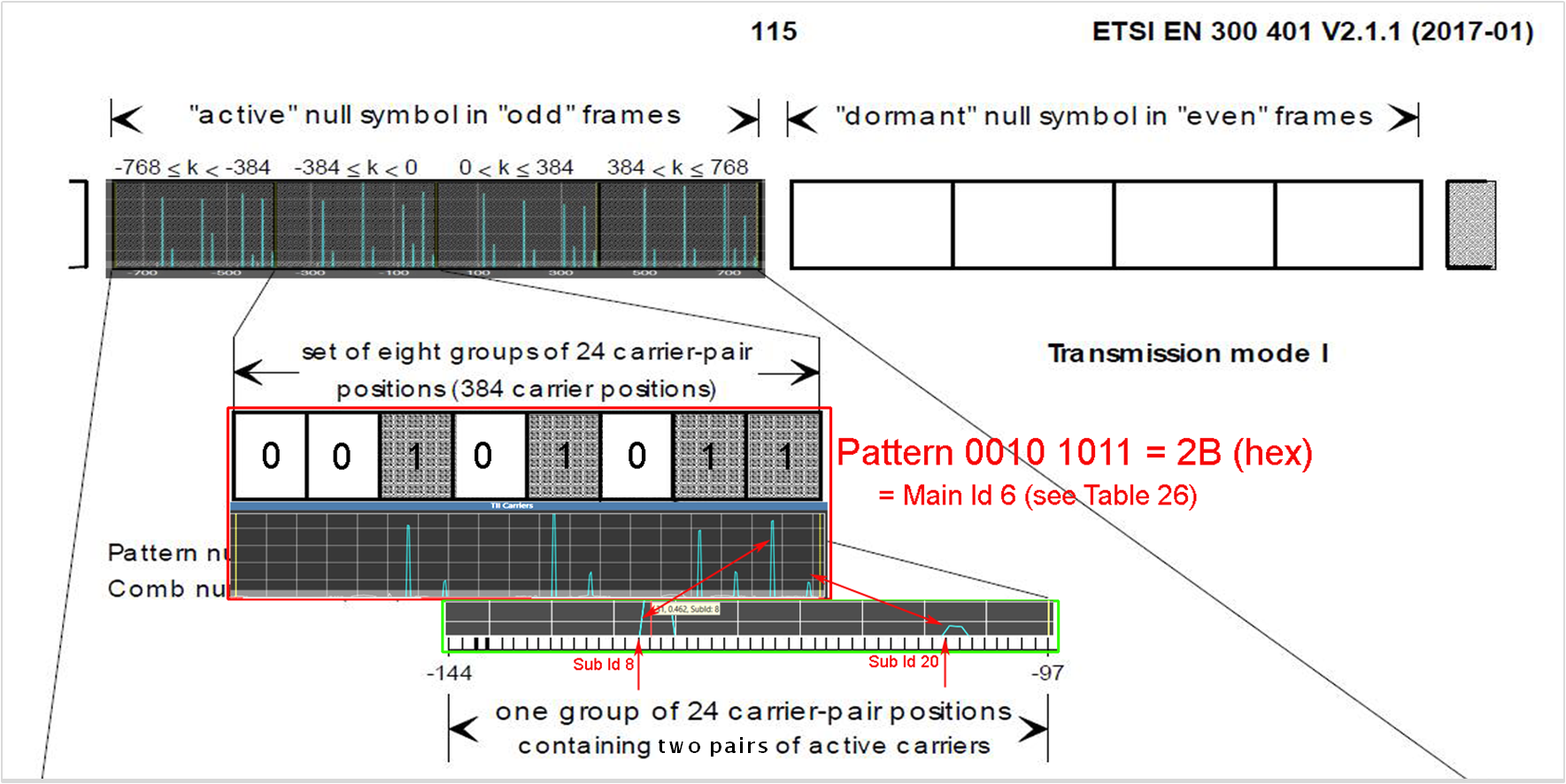
The picture shows the explanation of the TII Codes in the standard, overlaid with the scaled spectra taken as screenshots in QIRX and zoomed to
different levels with increasing details from top to bottom.
-
Upper Spectrum
It shows the whole spectrum, identical to the one shown above. The transparent ETSI drawing shows the four identical compartments indicating
on top the different carrier indices ranging from -768 to 768. In QIRX these ar shown as scale description.
-
Pattern Number from the Middle Spectrum (Red Frame)
It shows a zoom into one of the four identical compartments. The schematic drawing shows the eight blocks of identical size. The spectrum
indicates which four of eight blocks are occupied. 1 means occupied, 0 means not occupied. Building a binary number of the ones and zeros results in
the "Pattern" 00101011. This equals to 2B as a hexadecimal number, which is here mentioned only because the ETSI DAB spec shows (in their original example) the number as well.
Relevant is the binary "Pattern". Please note the presence of exactly four "1" entries.
-
Sub Ids from the Lower Spectrum (Green Frame)
This one further zooms into one of the eight blocks, showing the "comb" consisting of 24 carrier-pair positions.
In our spectrum two different active comb indices are present, 8 and 20, building the Sub Id of the two present TII Codes. Please ignore the
carrier ids below the spectrum, they belong to the example of the DAB spec.
-
Main Id
We are almost done. What is still missing is the Main Id. As mentioned above the "Pattern" is a 1:1 mapping of the Main Id. To find the corresponding one
we need to consult the ETSI DAB Standard again. The next picture shows the mapping table showing the "Patterns" of all 70 possibilities to
place four ones in eight boxes.
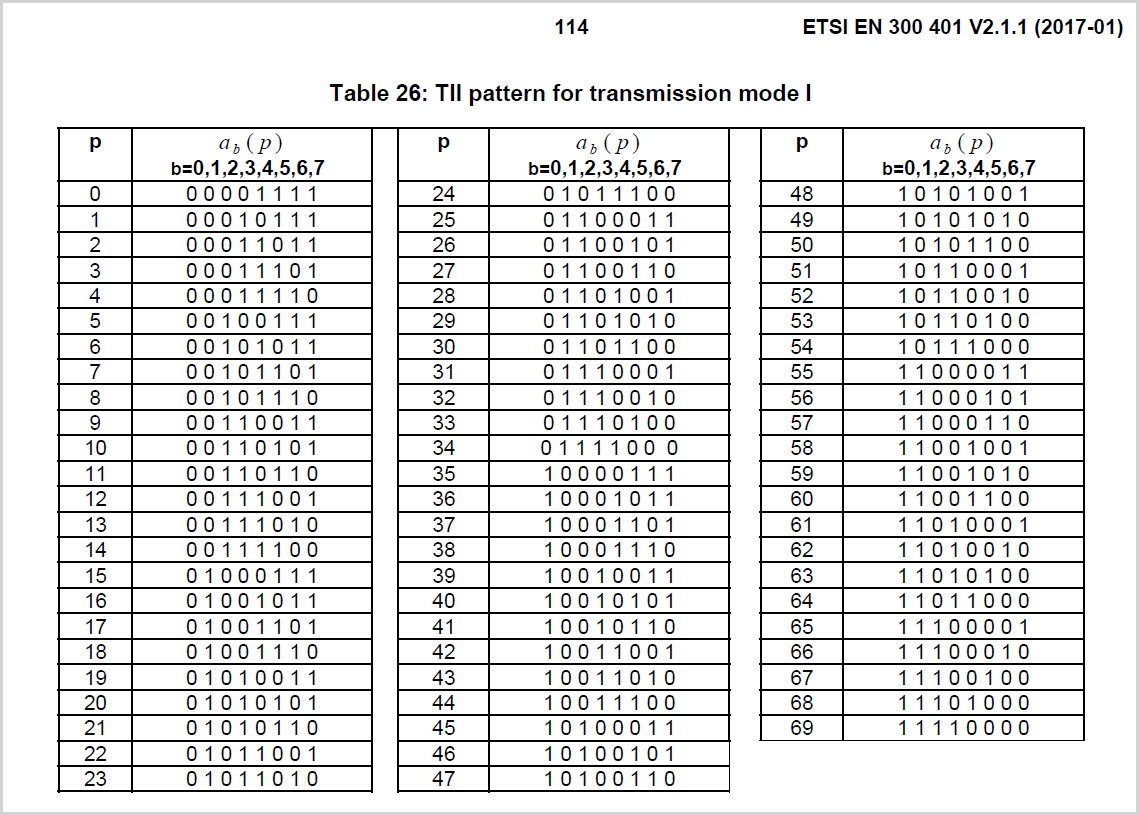
All we need to do is to find the entry number of our Pattern 00101011 in the table. We find it at number 6, which is our Main Id.
These numbers (Main/Sub Id) of 6/8 and 6/20 are shown in the QIRX TII table.

-
Carrier Identification in QIRX
Rather often the TII spectra do not look so nice as above, allowing easy visual identification of carrier groups belonging
to a TII Code. Therefore - as a visual help - it is possible in QIRX to select only those carriers of a TII Code. The next picture shows
as an example the selected carriers of 6/20 in blue, with the ones belonging to 6/8 deselected and painted in gray.

Digital Audio Broadcast (DAB) stations very often operate in a so-called "Single Frequency Network (SFN)".
In a SFN, they all transmit on the exactly same frequency, timely synchronized, disseminating the same content.
Very often not only one, but more transmitters contribute to the decoded audio of the receiver.
At the receiver side,
the only means to distinguish different transmitters in a SFN is their TII-Code (TII means Transmitter Identification Information),
extracted from the Null Symbol. Unfortunately, this TII Code is not guaranteed to be unique
like e.g. the ensemble id, but in certain circumstances it will become impossible
to extract the TII Code of a transmitter unambiguously.
Such a situation is what I call "TII Collision".
For an understanding what "TII Collisions" mean, we first need to understand how the TII Codes are extracted from the Null Symbol.
The Null Symbol
The "Null Symbol" is nothing more than controlled silence of 1.3ms. Every 96 milliseconds, a DAB station transmits - nothing -, making
a pause to give a receiver a chance to recognize the next starting instance of a so-called "frame". However that pause is not completely silent,
because just in there some carriers are activated which form the "TII Code".
But before we go into the details of how the TII Codes are constructed, let us first have a look at the Null Symbol.
The Null Symbol in the Time Domain
QIRX can show you the signal amplitude received over some time. The next picture is a QIRX screenshot of the I/Q Data, like
from an oscilloscope. The trigger point is the start of the new frame on the right hand side of the picture, adjusted by some delay to get the full
Null Symbol into display. "Time Domain" means that the horizontal scale is divided into units of time, however here not in seconds, but
in units of sample time. Each sample corresponds to a time of 1/2048000 seconds. Pretty fast, isn't it?
The picture shows the following:
-
On the left hand side the end of a frame is shown. You might well recognize the step, showing the end of not only one single
signal, but, at a reduced amplitude, also the end of a frame of a second transmitter, with some delay of about 150 samples.
For the overly curious, that very delay must show up also in the CIR spectrum. Check it out!
Therefore we conclude that we receive here our DAB signal from at least two transmitters simultaneously. We keep this result in mind for later, when we come to the "Frequency Domain" in a second.
The middle part shows you the "controlled silence" in the form of zero amplitude. For completeness of the picture, on the right hand side the "Phase Reference Symbol" of the newly started frame can be seen, which will be not of interest here.

-
But where is the TII Code?
Shouldn't it be somewhere in the Null Symbol?
Ok, admitted, I didn't tell you the whole truth. The TII Code does NOT show up in every Null Symbol, but only in every second one. This has technical reasons not of interest to us here. To see it in QIRX, you only must add a delay of 96ms (i.e. delay by a whole frame time), and voilá, there it is, contained in the strangley formed central part of the Null Symbol.

The different frequencies of the Null Symbol carriers superimpose each other, and form the active part of the Null Symbol. Again, just for the curious, there are two ways to superimpose, one is correct, and one is wrong. Here you see the correct one, with that notch in the middle. Some transmitter manufacturers didn't read the ETSI spec well enough, and did it wrong. The drawback of that sometimes wrong solution is another story, not of interest here.
The important question of interest is: "How can we extract the TII Codes from the Null Symbol".
Although I don't know for sure whether this is possible from the time domain signal, I assume nobody tried it, simply because it would not make much sense.
What makes a lot of sense is to leave the time domain and look at the Null Symbol in the "Frequency Domain", meaning that we investigate the different frequencies forming the TII Codes within the Null Symbol. A "Fast Fourier Transform" will get us there within some microseconds (on our current superfast machines). Ok, here we go.
The Null Symbol in the Frequency Domain
The next picture shows us the same Null Symbol as above in another representation, the Frequency Domain. Each of the colored lines represent
a single frequency in a spectrum of 2,048 different ones being active at the time when the Null Symbol is sent, i.e. every 2*96ms.

For an explanation how to extract the TII Code consisting of "Main Id" and "Sub Id" we will - in a first step - try to compare the explanation
given in the
ETSI DAB Standard
step-by-step with the spectrum shown above. In a second step it will become clear what it means when we say that "TII Collisions" might be present. Let us collect some properties
which might be extracted from the above spectrum, together with some additional information about the organisation of the TII spectrum.
- 16 strong colored lines, 16 weak colored lines. The strong lines belong to Station 1, the weak lines belong to Station 2. This information is a result of the TII Code retrieval procedure outlined below.
- There are four compartments separated by yellow dashed lines. All compartments carry the same information, but in different parts of the spectrum. This redundancy can be used to enhance the "Signal to Noise" ratio for weaker stations. For the TII Code retrieval, the carrier magnitudes of all compartments are added together, leading to a single compartment for the TII Code retrieval.
- Any of the four compartments is divided into eight blocks of equal size, not indicated in the picture. A block with a carrier in it is an active block. The crucial part here is that four active blocks MUST be present for a valid detection of a TII Code. This is a necessary condition, it is not yet sufficient.
- Any combination of four of the eight blocks is called a "Pattern". The pattern is a 1:1 mapping of the "Main Id" forming the first part of the TII Code. The number of all combinations of four possibilities out of a set of eight is 70. As a consequence 70 Main Ids are possible, not more.
-
Any of the eight different blocks is divided into 24 parts, called the "combs". Any such part is called comb index, ranging from zero to 23.
An active comb index is better known as the "Sub Id", forming the second part
of the TII Code. Each active comb index consists of two carriers directly neighboured, a so-called carrier pair.
As a result, each of the eight different blocks consists of 48 single frequencies, where each two frequencies may be activated by switching on a carrier
pair on a comb index, by the transmitter.
QIRX shows you the comb index, i.e. the Sub Id in the spectrum by hovering over a carrier. To find the exact Sub Id it is best to zoom into the TII spectrum, because there are so many comb indices. And that is exactly what we are going to do right now. -
We saw above the necessary condition that four active blocks must be present for a valid TII Code. The complete, i.e. necessary and sufficient condition is:
For a valid TII Code the same Sub Id must show up in exactly four of eight blocks, not more, not less.
The restriction of "exactly four" is the key to understanding TII Collisions.
Reading the DAB Standard Explanation
Because a picture says more than thousand words, let us try to find out the Main and Sub Ids of our spectrum by giving an example, constructed
from above by applying the given explanation and checking with the DAB standard.

The picture shows the explanation of the TII Codes in the standard, overlaid with the scaled spectra taken as screenshots in QIRX and zoomed to
different levels with increasing details from top to bottom.
-
Upper Spectrum
It shows the whole spectrum, identical to the one shown above. The transparent ETSI drawing shows the four identical compartments indicating on top the different carrier indices ranging from -768 to 768. In QIRX these ar shown as scale description. -
Pattern Number from the Middle Spectrum (Red Frame)
It shows a zoom into one of the four identical compartments. The schematic drawing shows the eight blocks of identical size. The spectrum indicates which four of eight blocks are occupied. 1 means occupied, 0 means not occupied. Building a binary number of the ones and zeros results in the "Pattern" 00101011. This equals to 2B as a hexadecimal number, which is here mentioned only because the ETSI DAB spec shows (in their original example) the number as well. Relevant is the binary "Pattern". Please note the presence of exactly four "1" entries. -
Sub Ids from the Lower Spectrum (Green Frame)
This one further zooms into one of the eight blocks, showing the "comb" consisting of 24 carrier-pair positions. In our spectrum two different active comb indices are present, 8 and 20, building the Sub Id of the two present TII Codes. Please ignore the carrier ids below the spectrum, they belong to the example of the DAB spec. -
Main Id
We are almost done. What is still missing is the Main Id. As mentioned above the "Pattern" is a 1:1 mapping of the Main Id. To find the corresponding one we need to consult the ETSI DAB Standard again. The next picture shows the mapping table showing the "Patterns" of all 70 possibilities to place four ones in eight boxes.

All we need to do is to find the entry number of our Pattern 00101011 in the table. We find it at number 6, which is our Main Id.
These numbers (Main/Sub Id) of 6/8 and 6/20 are shown in the QIRX TII table.

-
Carrier Identification in QIRX
Rather often the TII spectra do not look so nice as above, allowing easy visual identification of carrier groups belonging to a TII Code. Therefore - as a visual help - it is possible in QIRX to select only those carriers of a TII Code. The next picture shows as an example the selected carriers of 6/20 in blue, with the ones belonging to 6/8 deselected and painted in gray.

TII Collisions
With our knowledge how TII Codes work we are now very well equipped to see that by using this scheme freely some problems can arise.
We will construct some simple examples consisting of the TII Codes of two transmitters to find out the troublemakers.
-
Same Main Id, Different Sub Id
This is the case of our example described above in detail. The software first looks for the active carriers, i.e. the Sub Ids. In a second step it tries to find out whether the same active carriers are present in four out of eight different blocks. As this is done independently for all of the possible Sub Ids, our above scheme presents no problem. Main Id 6 is found independently for Sub Id 8 and Sub Id 20, all nice and clean. -
Different Main Id, Different Sub Id
This case also imposes no problems. As already stated, the different Sub Ids are treated independently from each other. Two different "Patterns" are found, no conflicts or collisions arise. -
Different Main Id, Same Sub Id
This is the trouble case. What happens here? Let's assume we have two transmitters with the TII Codes 6/8 (as above) and 7/8 in our SFN of interest. The two "Patterns" for Main Id 6 and Main Id 7 can be extracted from our above shown Table 26:-
Pattern Main Id 6
This one we know already, it is 00101011. -
Pattern Main Id 7
From Table 26 we get 00101101. -
What finds the Software?
As we assume the same Sub Id of e.g. 8, the software now tries to find all of the eight blocks where this "active comb index" of 8 is present.
But surprise: After having collected out of the eight blocks all the active ones, i.e. those with a comb index of 8 it finds the "Pattern"
00101111, showing five instead of the allowed four active blocks. It is the superset of the both contributing patterns for Main Id 6 and 7. Clearly, with the method described above based on the information in the standard, this cannot be resolved any more, it is no longer unambiguous. -
Possible Solution
Lets first check out all possible Main Ids for our bogus pattern with five ones 00101111:
0000 1111, Main Id 0
0010 0111, Main Id 1
0010 1101, Main Id 7
0010 1011, Main Id 6
0010 1110, Maín Id 8
This is the simplest collision case with five instead of four "1" entries in the "Pattern". We have the choice among five different possibilities. The next complex case would be six instead of four "1" entries. This would leave us with already fifteen possibilities. It is a result of simple combinatorics. -
How find the correct one?
QIRX takes the easy decision of offering ALL possible solutions to the user, and let him decide. How this can be accomplished will be presented in the next part of our tutorial, solving a "real-world" TII Collision problem.
-
Pattern Main Id 6
-
Same Main Id, Same Sub Id
Strangely enough, this case also exists. It might be found it in Croatia, Ensemble C201, Block 9C, "OIVCroatia DAB+". See the QIRX screenshot of the recording. Such a case is indistinguishable for QIRX. It is also a case of a TII Collision, however not covered in the second part of the tutorial.
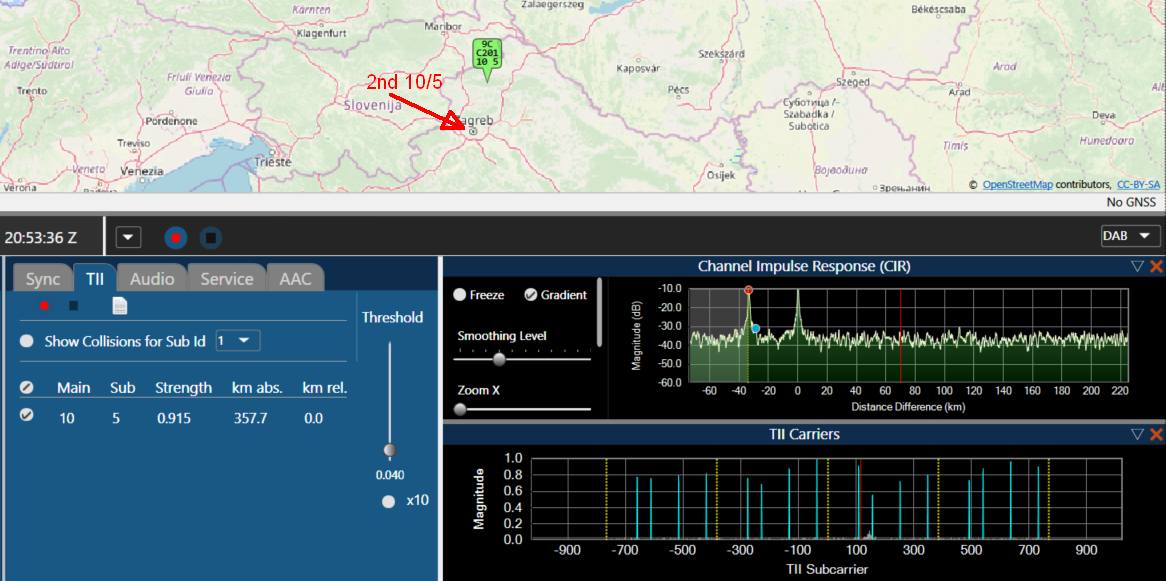
The CIR shows two strong peaks, fitting for the observer very well the locations of Ivanščica and Zagreb/Sljeme from the DABLIST.
The credit for finding it out goes to Petr OK2HF, who brought it to my attention.
